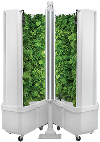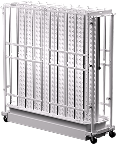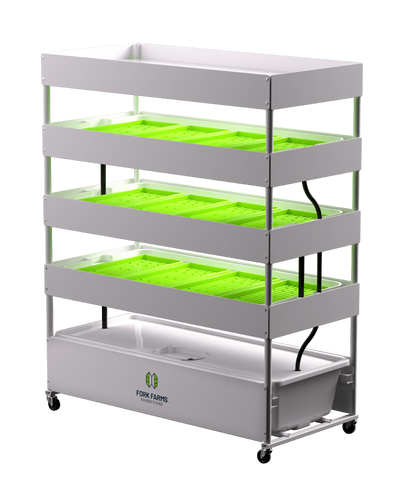How to Grow More Food with Your Hydroponic Farm System
Hydroponics is an innovative method of growing plants without soil, where nutrients are delivered to the roots via a water-based solution. This cutting-edge approach to farming offers remarkable benefits over traditional methods. It allows growers to produce more and healthier crops faster, in a smaller area, and in a controlled environment. What's more, hydroponic systems can operate year-round, providing a consistent supply of fresh produce regardless of the season.
High Yield In A Small Area
The cornerstone of hydroponic farming is its incredible space efficiency. Unlike traditional farming, which often requires substantial land, hydroponics is designed to produce large amounts of food in compact spaces. Most systems are designed so you can pack your plants closer together for maximum efficiency, significantly boosting your garden's output. Many can be stacked vertically, too, allowing for multiple layers of crops to grow simultaneously.
Hydroponics opens up the possibility of fresh, local food production wherever space is at a premium, whether it is from rooftops, balconies, basements, closets, or any number of indoor settings.
Techniques To Maximize Your Hydroponics Farm Yield
There are several different techniques growers can use to get the most out of their hydroponic systems. These include choosing high-yield plant varieties like lettuce, spinach and certain brassicas, ensuring plants receive the right amount and type of light exposure while maintaining optimal growing conditions.
Monitoring the water’s pH levels, overall temperature, humidity, and airflow, and regularly pruning and harvesting plants to encourage continued growth are important steps as well.
Another way to grow more food with a hydroponic system is by optimizing their nutrient concentrations, which can be done by implementing a nutrient cycling system. This method involves recirculating and reusing the nutrient solution, rather than constantly replacing it. By recycling the nutrient solution, you can save on costs and reduce waste and water use, while still providing the plants with the essential nutrients they need to grow.
Scaling Up Your Hydroponic Farm To Grow More Food
Following best practices can certainly help boost your existing garden’s productivity. But for larger-scale production goals, the best option may be to expand the operation. Fortunately, one of the most appealing aspects of hydroponic gardening is its modular nature. You can start small and scale up as you become more comfortable and your needs increase. This flexibility allows for a gradual investment, making it a great option for hobbyists as well as those looking to produce larger quantities of food, up to and including commercial growers.
Scaling up a hydroponic farming system generally involves some fundamental steps and considerations. For example, you’ll want to assess certain aspects of your current setup like its size and layout, the types of plants being grown, and the efficiency of the system. Any expansion plans should take into account the strengths and limitations of your existing garden in order to maximize future productivity.
A few other factors to consider are the availability of space, since a larger system will require more room for additional growing units, nutrient reservoirs, and support infrastructure; the nutrient delivery system itself (pumps, pipes, sensors, etc.); additional grow lights; and potentially water quality testing equipment and filtration systems to make sure there are no impurities or contaminants in your water supply.
Plus, a larger operation is going to require more maintenance and a greater time commitment, so it’s important to factor that additional workload, and who will manage it, into your plans.
For commercial operators, this could involve hiring additional staff, and investing in training to ensure that all employees are knowledgeable on proper hydroponic farming techniques. It also means developing a business plan that outlines the goals of the expansion, and what resources may be needed to support it. Investment in research and development, keeping up to date with industry trends, and collecting data on the farming system’s performance will also likely come into play.
A Superior Hydroponic Farm Solution
If you’ve been following this blog, you’re probably aware of Fork Farms’ revolutionary hydroponics system, the Flex Farm. This highly scalable, indoor mobile hydroponic farm requires less than 10-square-feet of growing space, yet is capable of producing 25-plus pounds of fresh food every 28 days, or more than 394 pounds of leafy greens and herbs each year. Plus, it is mobile, making it ideal for homes, schools, community projects, or almost any other application.
If your production goals exceed the capacity of a single system. Fork Farms makes it easy to scale up with the Flex Connect. Designed for larger operations, the Flex Connect links multiple Flex Farms–ranging from four to 12–to a single water system. Its modular design makes it easy to expand crop production with minimal maintenance, efficient energy use, and nutrient delivery. You can even scale up further by adding more Flex Connects.
The Flex Connect system comes with support from the Fork Farms team, who can assist in surveying your site and help you plan your operation. You also gain access to Fork Farms' free Farmative community for large-scale growers, as well as enrollment in a special cultivation program for farmers with more than 12 Flex Farms. This program, which offers one-on-one technical support and assistance, includes weekly calls through the first crop rotation, followed by ongoing communications to check the status of your farm, offer tips to optimize plant growth, and ensure your growing goals are being met.
At the upper end of the spectrum–for operations with 48 or more Flex Farms–there is the Flex Acre system designed for large school districts or universities, corporations and experienced farmers. This enterprise-level system uses advanced technology that allows communities to grow a significant amount of fresh produce in a small space. Standing 9 feet high, 9 feet long, and 3 feet wide, the Flex Acre can produce more than 100 pounds of fresh food each month.
Its flexible construction even allows you to run multiple Flex Acres, up to 12, off of a single water system. Plus, the Flex Acre can be outfitted with a fully integrated HVAC, power, and plumbing solution through a breakthrough technology developed specifically for large farm operations running Flex Acres. In terms of growing capacity, just four Flex Acres can accommodate more than 4,600 individual plants, and produce upwards of 400 pounds of leafy greens per month.
Get Started On Your Journey
Whether your production goals call for a single Flex Farm or multiple Flex Acres, Fork Farms has the hydroponic system designed to meet your needs. For more information, or to get started on your own growing journey, connect with one of our expert team members today!
Important Links:
























